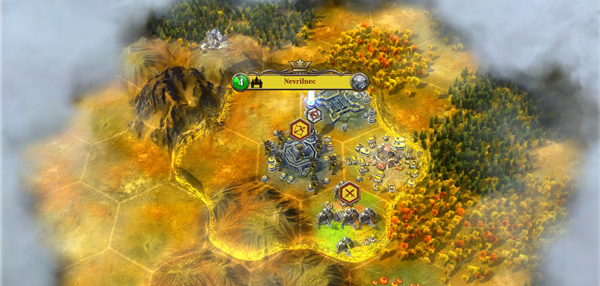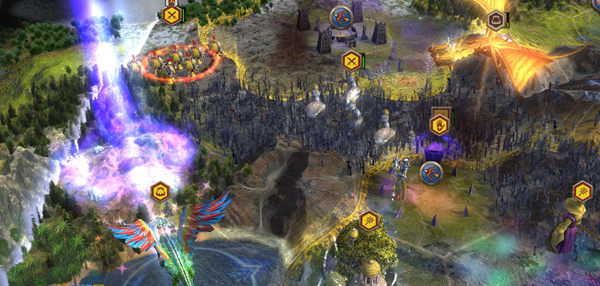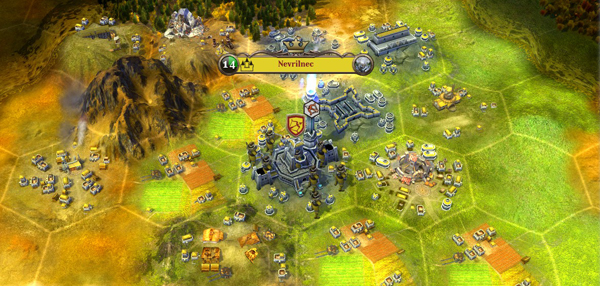It’s difficult to judge Warlock 2 on its own merits. Obviously as the sequel to 2012’s Warlock: Master of the Arcane it will draw close comparison, but even a cursory glance at the screenshots will put many in mind of Civilization V too. Before weighing it up against the competition though, we should examine the game on what it presents.
The meat of Warlock 2 is a turn based strategy game where you build cities in order to dominate the land and produce units with which to explore and conquer. This is no simple task – the world is full of unpleasant monsters which must be cleared out first, and many of them will be more than a match for your troops. Fortunately city buildings and experience will allow you to empower your units with skills and upgrades which can balance the odds for a while, but the whole game will be an arms race against the monsters. On top of the fauna, there are a number of other mages – the off-map overseers of each empire – making their own designs on the world.
The world itself is divided into shards of various sizes and environments, linked by portals. The variety is impressive, ranging from the mundane but productive pastures and tundra, to the more spectacular death or elemental lands. Each has its own flavour of hostile creatures and useful resources. The type of terrain isn’t quite as important as it might be in a more conventional setting – among your book of spells, containing the usual damage, healing and buffs, are terraforming spells that allow you to pretty much configure each city as you like given enough time and resources.
The option of tailoring your cities is essential to the running of your empire, due to one of Warlock 2’s most interesting departures from the strategy norm: Your empire has a maximum limit to how many cities you can have at any given time. At first this is frustrating, but once you abandon the mindset of conquest through unfettered growth it becomes liberating. That isn’t to say you can’t dominate the map with cities though, the limit only applies to those under your direct control. Other cities captured or settled can be assigned to specialist roles and do not contribute to the cap, although they don’t expand or produce units. The limit isn’t a hard ceiling either, you can go over that limit at the expense of population happiness. This allows you to capture cities and take the happiness hit while you re-purpose them. The most significant impact on the game, though, is that it forces you to consider exactly where to position each one you do maintain, what strategic resources it will give you, what units it will produce. Decisions must be made whether to abandon a potentially valuable resource to an automated city, or abandon an established city and take the production hit while you build up the new one. In the later stages of the game it isn’t as simple a choice as it may sound, because to survive against the more powerful roaming monsters you will need those resources and advanced troops.
In contrast to the grand strategy of the core game, there is a light element of RPG to it. At various points you will be able to recruit hero units, powerful (but not invincible) individuals who can be equipped with magic items and will likely form the core of your armies. The main campaign is quest based, setting you objectives with the ultimate goal to overthrow the United One and his henchmen. It’s an interesting journey – each of the bad guys will interfere with you in different ways by casting spells or summoning monsters until you complete the quest to stop them. This interference swings between interesting diversion to irritatingly distracting, but in either case it breaks up the constant push of conquest.
So how does it compare to its contemporaries? Warlock 2 may have some longetivity issues when compared to Civ V. The game isn’t as complex and suffers from a lack of victory conditions, and while it isn’t designed to be an empire builder the wargame focus doesn’t quite fill the gap. Compared to Warlock it improves in almost every way, but loses the grand wargame feel due to late game being deadly to all but a handful of the highest powered units. The improvements aren’t huge or significant though, and owners of the first game could be forgiven for feeling like Warlock 2 is a full priced expansion, but anyone who played Civ V and wanted more war, or anyone who’s been hankering for a new Master of Magic, could do far worse than to take a look.



